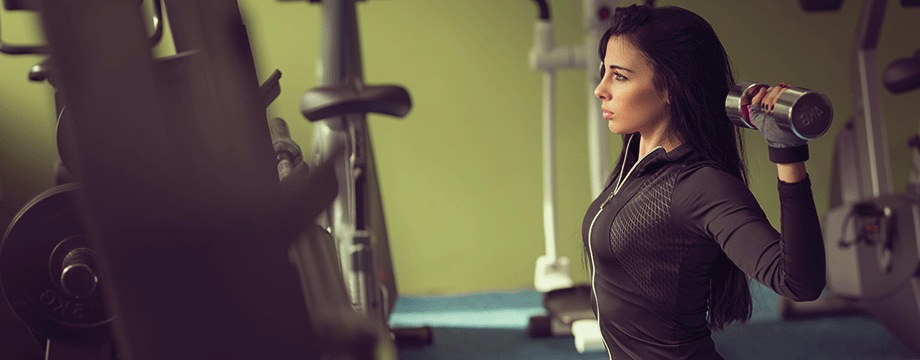Fact or fiction?

We take a look at the truth behind some of the most popular fitness myths
With so much information on fitness and training available on the internet, which at times can be conflicting, it can be hard to separate fact from fiction. A new poll of 149 managers from PureGym (www.puregym.com) has revealed the common gym misconceptions believed by gym-goers in the UK. From worries about bulking up, to focusing all our attention on cardio, it seems that there is a lot of confusion about the best way to get the most out of our workouts. Here, the experts from PureGym take a look at some of the most common gym misconceptions and explain why these myths aren’t necessarily true.
Myth no 1
Lifting weights will result in a bulky physique
Why do we believe it? Many people have heard the phrase ‘bulking up’, which is commonly used to refer to a phase of building muscle by burning fewer calories than you eat. A common misconception is to think that weight training only increases muscle size instead of helping to shape and tone or strengthen.
What’s the truth? PureGym expert Marni says: “Despite the growing popularity of female weight training, I still find many females worry about this, but science shows that women do not have the same testosterone levels to build the same amount of muscle as men. Building muscle doesn’t happen overnight. Beginners may initially have the advantage to build muscle at a faster rate than experienced lifters, but they will often see the rate of growth slows down as they become more experienced. If you’ve noticed, just after working out in the gym, that the body parts you’ve worked feel larger, this feeling can often be mistaken for being muscle gain but is usually a result of blood being pumped to the area. This usually wears off about an hour after training and is most likely not a change in muscle mass.”
Myth no 2
If you don’t feel sore, you haven’t had a good workout
Why do we believe it? Because sometimes feeling achy is a sign that you’ve pushed and put stress on your muscles, but it’s not the only sign of an effective workout.
What’s the truth? PureGym expert Sky says: “Muscle soreness comes from micro-tears in muscle, mostly from new exercise or stimulus. You will usually feel a lot of muscle soreness when starting a new programme or exercise regime as your body is pushed beyond what it is used to. These micro-tears are necessary for your muscles to grow, but require adequate rest and nutrition for your body to repair and rebuild your muscle fibres. The stronger you get and the more your body adjusts to the new stimulus, the less soreness you will experience, so that’s not to say you didn’t get a good workout. You shouldn’t be feeling sore after every workout and you certainly shouldn’t feel pain. There’s a fine line between challenging yourself and hurting yourself so make sure to find that right balance.”
Myth no 3
If you don’t sweat, you didn’t work out properly
Why do we believe it? For many of us, sweating appears to be a great indicator that the exercise we’re doing is effective because it’s a sign we’re working hard.
What’s the truth? PureGym expert Sky says: “Sweating is just a response to an increase in your core temperature and is your body’s way of cooling down. Some people may naturally sweat more than others and some people may find they don’t sweat much, so it isn’t necessarily a measure of how hard you worked.”
Myth no 4
You shouldn’t do cardio on the same day as weight training
Why do we believe it? Because some research shows mixing up your workouts in the same session without a proper recovery time can limit the benefits you get from each.
What’s the truth? PureGym expert Kay says: “It’s okay to perform cardio and weight training on the same day, as long as this is based around your needs and goals, but give yourself enough time to rest and get adequate nutrition. There are athletes and gym goers who do cardio and weight training on the same day. Ultimately, how you train and your exercise selection should be based around what’s best for you and your goals.”
Myth no 5
Cardio is the number one way to lose weight
Why do we believe it? Because cardio (aerobic exercises) like running, cycling and swimming is a great way to increase your energy expenditure to aid in weight loss. When comparing jogging to lifting weights, the former is a more accessible option for many. Coupled with the common belief that cardio is superior in burning calories versus weight training, and the worry some people still have that lifting weights can make you bulky, we can see why this has become a popular gym myth.
What’s the truth? PureGym expert Kay says: “If your goal is weight loss it’s important to remember that you will likely not only be burning fat but losing muscle mass too. By including weight training into your routine alongside cardiovascular activities you can help to offset the rate of muscle mass loss. Your muscle mass can influence your basal metabolic rate, which influences how many calories you naturally burn at rest. Therefore, although cardio does appear superior over weight training in regard to initial calories burnt, weight training has been shown to increase the calories burnt after an initial exercise period. Plus, weight training also provides lots of other health benefits that you may not get from cardiovascular exercise, such as improving strength and bone density. Ultimately weight loss is dependent on energy balance. You need to be in an energy deficit to lose weight. Other elements like nutrition, recovery and sleep can impact weight loss so these should also be considered.”
Read previous Your Health articles here...
Read articles from our latest issue here...